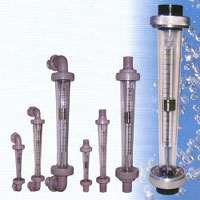ROTA METERS

A rota meter is a device that measures the flow rate of liquid or gas in a closed tube. It belongs to a class of meters called variable area meters, which measure flow rate by allowing the cross-sectional area the fluid travels through to vary, causing some measurable effect.
The float moves up and down inside the rotameter's tapered tube proportionally to the flow rate of the fluid. It reaches a constant position once the fluid and gravitational forces have equalized. Changes in the flow rate cause rotameter's float to change position inside the tube. Since the float position is based on gravity it is important that all rotameters be mounted vertically and oriented with the widest end of the taper at the top. It is also important to remember that if there is no flow the float will sink to the bottom of the rotameter due to its own weight.
The operator reads the flow from a graduated scale on the side of the rotameter, which has been calibrated to a specific fluid with a known specific gravity. Specific gravity or the weight of the fluid has a great impact on the rotameter's accuracy and reliability. All of Global Water's rotameters have been calibrated using water as the standard fluid with a specific gravity of 1.0.
Rotameters can be calibrated for other fluids by understanding the basic operating principles. Rotameter accuracy is determined by the accuracy of the pressure, temperature, and flow control during the initial calibration. Any change in the density and weight of the float will have impacts on the rotameter's flow reading. Additionally any changes that would affect the fluid such as pressure or temperature will also have an affect on the rotameter's accuracy. Given this, rotameters should be calibrated yearly to correct for any changes in the system that may have occurred.